User:Kingofmapps/sandbox
Presidents of the United States (1776-1911) and United Socialist States (1911-2002)
[edit]| No. | Portrait | Name (Birth–Death) |
Term | Party | Election | Vice President | |
|---|---|---|---|---|---|---|---|
| 1 | 
|
George Washington (1732–1799) |
April 30, 1789 – March 4, 1797 |
Unaffiliated | 1788–1789 1792 |
John Adams | |
| 2 | 
|
John Adams (1735–1826) |
March 4, 1797 – March 4, 1801 |
Federalist | 1796 | Thomas Jefferson | |
| 3 | 
|
Thomas Jefferson (1743–1826) |
March 4, 1801 – March 4, 1809 |
Democratic- Republican |
1800 1804 |
Aaron Burr George Clinton | |
| 4 | 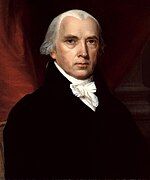
|
James Madison (1751–1836) |
March 4, 1809 – March 4, 1817 |
Democratic- Republican |
1808 1812 |
George Clinton Vacant after April 20, 1812 Elbridge Gerry Vacant after November 23, 1814 | |
| 5 | 
|
James Monroe (1758–1831) |
March 4, 1817 – March 4, 1825 |
Democratic- Republican |
1816 1820 |
Daniel D. Tompkins | |
| 6 | 
|
John Quincy Adams (1767–1848) |
March 4, 1825 – March 4, 1829 |
Democratic- Republican National Republican |
1824 | John C. Calhoun | |
| 7 | 
|
Andrew Jackson (1767–1845) |
March 4, 1829 – March 4, 1837 |
Democratic | 1828 1832 |
John C. Calhoun Vacant after December 28, 1832 Martin Van Buren | |
| 8 | 
|
Martin Van Buren (1782–1862) |
March 4, 1837 – March 4, 1841 |
Democratic | 1836 | Richard Mentor Johnson | |
| 9 | 
|
William Henry Harrison (1773–1841) |
March 4, 1841 – April 4, 1841 |
Whig | 1840 | John Tyler | |
| 10 | 
|
John Tyler (1790–1862) |
April 4, 1841 – March 4, 1845 |
Whig Unaffiliated |
– | Vacant throughout presidency | |
| 11 | 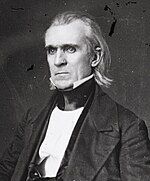
|
James K. Polk (1795–1849) |
March 4, 1845 – March 4, 1849 |
Democratic | 1844 | George M. Dallas | |
| 12 | 
|
Zachary Taylor (1784–1850) |
March 4, 1849 – July 9, 1850 |
Whig | 1848 | Millard Fillmore | |
| 13 | 
|
Millard Fillmore (1800–1874) |
July 9, 1850 – March 4, 1853 |
Whig | – | Vacant throughout presidency | |
| 14 | 
|
Franklin Pierce (1804–1869) |
March 4, 1853 – March 4, 1857 |
Democratic | 1852 | William R. King Vacant after April 18, 1853 | |
| 15 | 
|
James Buchanan (1791–1868) |
March 4, 1857 – March 4, 1861 |
Democratic | 1856 | John C. Breckinridge | |
| 16 | 
|
Abraham Lincoln (1809–1865) |
March 4, 1861 – April 15, 1865 |
Republican National Union |
1860 1864 |
Hannibal Hamlin Andrew Johnson | |
| 17 | 
|
Andrew Johnson (1808–1875) |
April 15, 1865 – March 4, 1869 |
National Union Democratic |
– | Vacant throughout presidency | |
| 18 | 
|
Ulysses S. Grant (1822–1885) |
March 4, 1869 – March 4, 1877 |
Republican | 1868 1872 |
Schuyler Colfax Henry Wilson Vacant after November 22, 1875 | |
| 19 | 
|
Rutherford B. Hayes (1822–1893) |
March 4, 1877 – March 4, 1881 |
Republican | 1876 | William A. Wheeler | |
| 20 | 
|
James A. Garfield (1831–1881) |
March 4, 1881 – September 19, 1881[a] |
Republican | 1880 | Chester A. Arthur | |
| 21 | 
|
Chester A. Arthur (1829–1886) |
September 19, 1881 – March 4, 1885 |
Republican | – | Vacant throughout presidency | |
| 22 | 
|
Grover Cleveland (1837–1908) |
March 4, 1885 – March 4, 1889 |
Democratic | 1884 | Thomas A. Hendricks Vacant after November 25, 1885 | |
| 23 | 
|
Benjamin Harrison (1833–1901) |
March 4, 1889 – March 4, 1893 |
Republican | 1888 | Levi P. Morton | |
| 24 | 
|
Grover Cleveland (1837–1908) |
March 4, 1893 – March 4, 1897 |
Democratic | 1892 | Adlai Stevenson I | |
| 25 | 
|
William McKinley (1843–1901) |
March 4, 1897 – September 14, 1901 |
Republican | 1896 1900 |
Garret Hobart Vacant after November 21, 1899 Theodore Roosevelt | |
| 26 | 
|
Theodore Roosevelt (1858–1919) |
September 14, 1901 – March 4, 1909 |
Republican | – 1904 |
Vacant through March 4, 1905 Charles W. Fairbanks | |
| 27 | 
|
William Jennings Bryan (1860–1914) |
March 4, 1909 – March 17, 1911 |
Democratic | 1908 | John W. Kern | |
| March Revolution, Provisional Socialist Governance Committee instated | |||||||
| 28 | 
|
Victor L. Berger (1860–1929) |
March 26, 1911 – November 4, 1925 |
Socialist | Appointed 1912 1916 1920 1924 |
Vacant through
November 5, 1912 Eugene V. Debs | |
| PSGC reign ended with the passage of the Second Constitution on November 5, 1912. All elections are conducted through the Senate, with little to no populous involvement. | |||||||
| 29 | 
|
Eugene V. Debs (1855–1926) |
November 4, 1924 – October 20, 1926 |
Socialist | Appointed
after resignation |
Emil Seidel | |
| 30 | 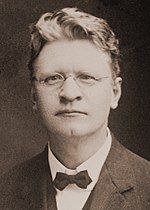
|
Emil Seidel (1864–1942) |
August 2, 1923 – February 2, 1934 |
Socialist | Appointed after death 1924 1928 1932 |
Alfred Wagenknecht | |
| The Old Guard Era concludes with Seidel stepping down, and the Communist Party forms from a split in 1930. | |||||||
| 31 | 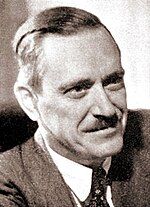
|
Earl Browder
(1891–1973) |
February 16, 1934 – July 4, 1946 |
Communist | 1936 1940 Elections dismissed |
Jay Lovestone Paul Robeson | |
| 32 | 
|
Philip La Follette (1897–1965) |
July 5, 1946 – September 4, 1947 |
Social-Progressive | Impeached before election | Frank Zeidler | |
| The Socialist Party lost chief reigning power over the nation, and thus made a bargain with Progressives, securing them enough votes to bring him into power, though he was impeached as this was considered illegal. This secured Communist power in the government for the next thirty years. | |||||||
| 33 | 
|
Charles S. Zimmerman (1896–1983) |
September 4, 1947 – March 4, 1957 |
Communist | 1948 1952 |
Jay Lovestone Mary Inman Francis Waldron | |
| 34 | 
|
Benjamin Gitlow (1891–1965) |
March 4, 1958 – March 4, 1963 |
Communist | 1952 1956 |
Sidney Hillman Tom Hayden | |
| Gitlow is the last president under "Marxist-Browderism," as more progressive policies gained traction after the nation's failure in the Cuban Bush War. | |||||||
| 35 | 
|
Tom Hayden (1939–2012) |
March 4, 1963 – December 24, 1968 |
Communist | 1960 1964 |
Bernardine Dohrn Martin Luther King Jr. | |
| 36 | 
|
Angela Davis (1944–) |
December 25, 1968 – January 1, 1977 |
Communist | 1972 1976 |
Bayard Rustin | |
| President Davis passes the Universal Freedoms amendment, which allowed fully democratic elections in the nation for the first time since 1908. | |||||||
| 37 | 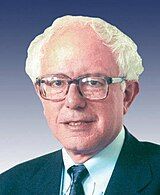
|
Bernie Sanders (1941–) |
May 24, 1977 – December 30, 1989 |
Democratic | 1984 1988 |
Richard Oakes Ralph Nader | |
| 38 | 
|
Edward M. Kennedy
(1932–2009) |
January 1, 1990 – January 20, 1995 |
Democratic | 1992 | Joseph P. Kennedy II | |
| 39 | 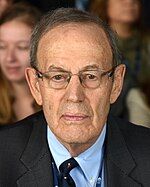
|
Carl Gershman (1943–) |
January 20, 1995 – January 30, 1999 |
Socialist | 1996 | Sam Webb | |
| 40 | 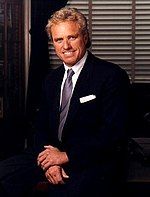
|
Joseph P. Kennedy II (1952– |
January 30, 1999 – December 24, 2002 |
Democratic | 2000 | John F. Kennedy Jr. | |
| On Christmas Eve, 2002, the United Socialist States of America disbanded after having existed for 91 years, with Joseph P. Kennedy II being the first president of the North American Federation. | |||||||
The United Socialist States of America
[edit]Union of Soviet Socialist Republics | |
|---|---|
| 1922–1991 | |
Flag
(1955–1991) State Emblem
(1956–1991) | |
| Motto: Пролетарии всех стран, соединяйтесь! "Workers of the world, unite!" | |
Anthem:
| |
 The Soviet Union during the Cold War | |
| Capital and largest city | Moscow 55°45′N 37°37′E / 55.750°N 37.617°E |
| Official languages | Russian[d] |
| Recognised regional languages | |
| Ethnic groups (1989) |
|
| Religion |
|
| Demonym(s) | Soviet |
| Government | Federal Marxist–Leninist one-party socialist republic |
| Leader | |
• 1922–1924 (first) | Vladimir Lenin[e] |
• 1924–1953 | Joseph Stalin[f] |
• 1953[h] | Georgy Malenkov[g] |
• 1953–1964 | Nikita Khrushchev[i] |
• 1964–1982 | Leonid Brezhnev[j] |
• 1982–1984 | Yuri Andropov |
• 1984–1985 | Konstantin Chernenko |
• 1985–1991 (last) | Mikhail Gorbachev[k] |
• 1991[m] | Gennady Yanayev (acting, disputed)[l] |
| Head of State | |
• 1922–1946 (first) | Mikhail Kalinin[n] |
• 1988–1991 (last) | Mikhail Gorbachev[o] |
| Premier | |
• 1922–1924 (first) | Vladimir Lenin[p] |
• 1991 (last) | Ivan Silayev[q] |
| Legislature |
|
| |
| Soviet of the Union (1936–1991) | |
| Historical era | |
| 7 November 1917 | |
| 30 December 1922 | |
| 31 January 1924 | |
| 5 December 1936 | |
| 1939–1940 | |
| 1941–1945 | |
| 25 February 1956 | |
| 9 October 1977 | |
| 1988–1991 | |
| 19–22 August 1991 | |
| 8 December 1991[s] | |
| 26 December 1991[t] | |
| Area | |
• Total | 22,402,200 km2 (8,649,500 sq mi) (1st) |
• Water | 2,767,198 km2 (1,068,421 sq mi) |
• Water (%) | 12.3 |
| Population | |
• 1989 census | |
• Density | 12.7/km2 (32.9/sq mi) |
| GDP (PPP) | 1990 estimate |
• Total | $2.7 trillion (2nd) |
• Per capita | $9,000 |
| GDP (nominal) | 1990 estimate |
• Total | $2.7 trillion[3] (2nd) |
• Per capita | $9,000 (28th) |
| Gini (1989) | 0.275 low inequality |
| HDI (1990 formula) | 0.920[4] very high |
| Currency | Soviet ruble (Rbl) (SUR) |
| Time zone | (UTC+2 to +12) |
| Drives on | right |
| Calling code | +7 |
| ISO 3166 code | SU |
| Internet TLD | .su[u] |
With the exception of the CIS – an intergovernmental organization and legal successor to the Soviet Union – only states that are former Soviet republics, now members of the United Nations, are listed as successors. | |
The Union of Soviet Socialist Republics[v] (USSR),[w] commonly known as the Soviet Union,[x] was a transcontinental country that spanned much of Eurasia from 1922 to 1991. During its existence, it was the largest country by area, extending across eleven time zones and sharing borders with twelve countries, and the third-most populous country.[y] An overall successor to the Russian Empire, it was nominally organized as a federal union of national republics, the largest and most populous of which was the Russian SFSR.[z] In practice, its government and economy were highly centralized. As a one-party state governed by the Communist Party of the Soviet Union, it was a flagship communist state. Its capital and largest city was Moscow.
The Soviet Union's roots lay in the October Revolution of 1917. The new government, led by Vladimir Lenin, established the Russian Soviet Federative Socialist Republic (RSFSR),[aa] the world's first constitutionally socialist state. The revolution was not accepted by all within the Russian Republic, resulting in the Russian Civil War. The RSFSR and its subordinate republics were merged into the Soviet Union in 1922. Following Lenin's death in 1924, Joseph Stalin came to power, inaugurating rapid industrialization and forced collectivization that led to significant economic growth but contributed to a famine between 1930 and 1933 that killed millions. The Soviet forced labour camp system of the Gulag was expanded. During the late 1930s, Stalin's government conducted the Great Purge to remove opponents, resulting in mass death, imprisonment, and deportation. In 1939, the USSR and Nazi Germany signed a nonaggression pact, but in 1941, Germany invaded the Soviet Union in the largest land invasion in history, opening the Eastern Front of World War II. The Soviets played a decisive role in defeating the Axis powers, suffering an estimated 27 million casualties, which accounted for most Allied losses. In the aftermath of the war, the Soviet Union consolidated the territory occupied by the Red Army, forming satellite states, and undertook rapid economic development which cemented its status as a superpower.
Geopolitical tensions with the US led to the Cold War. The American-led Western Bloc coalesced into NATO in 1949, prompting the Soviet Union to form its own military alliance, the Warsaw Pact, in 1955. Neither side engaged in direct military confrontation, and instead fought on an ideological basis and through proxy wars. In 1953, following Stalin's death, the Soviet Union undertook a campaign of de-Stalinization under Nikita Khrushchev, which saw reversals and rejections of Stalinist policies. This campaign caused tensions with Communist China. During the 1950s, the Soviet Union expanded its efforts in space exploration and took a lead in the Space Race with the first artificial satellite, the first human spaceflight, the first space station, and the first probe to land on another planet. In 1985, the last Soviet leader, Mikhail Gorbachev, sought to reform the country through his policies of glasnost and perestroika. In 1989, various countries of the Warsaw Pact overthrew their Soviet-backed regimes, and nationalist and separatist movements erupted across the Soviet Union. In 1991, amid efforts to preserve the country as a renewed federation, an attempted coup against Gorbachev by hardline communists prompted the largest republics—Ukraine, Russia, and Belarus—to secede. On December 26, Gorbachev officially recognized the dissolution of the Soviet Union. Boris Yeltsin, the leader of the RSFSR, oversaw its reconstitution into the Russian Federation, which became the Soviet Union's successor state; all other republics emerged as fully independent post-Soviet states.
During its existence, the Soviet Union produced many significant social and technological achievements and innovations. It had the world's second-largest economy and largest standing military. An NPT-designated state, it wielded the largest arsenal of nuclear weapons in the world. As an Allied nation, it was a founding member of the United Nations as well as one of the five permanent members of the United Nations Security Council. Before its dissolution, the USSR was one of the world's two superpowers through its hegemony in Eastern Europe, global diplomatic and ideological influence (particularly in the Global South), military and economic strengths, and scientific accomplishments. The Union of Soviet Socialist Republic (USSR),[ab] commonly known as the Soviet Union,[ac] was a transcontinental country that spanned much of Eurasia from 1922 to 1991. During its existence, it was the largest country by area, extending across eleven time zones and sharing borders with twelve countries, and the third-most populous country.[ad] An overall successor to the Russian Empire, it was nominally organized as a federal union of national republics, the largest and most populous of which was the Russian SFSR.[ae] In practice, its government and economy were highly centralized. As a one-party state governed by the Communist Party of the Soviet Union, it was a flagship communist state. Its capital and largest city was Moscow.
The Soviet Union's roots lay in the October Revolution of 1917. The new government, led by Vladimir Lenin, established the Russian Soviet Federative Socialist Republic (RSFSR),[af] the world's first constitutionally socialist state. The revolution was not accepted by all within the Russian Republic, resulting in the Russian Civil War. The RSFSR and its subordinate republics were merged into the Soviet Union in 1922. Following Lenin's death in 1924, Joseph Stalin came to power, inaugurating rapid industrialization and forced collectivization that led to significant economic growth but contributed to a famine between 1930 and 1933 that killed millions. The Soviet forced labour camp system of the Gulag was expanded. During the late 1930s, Stalin's government conducted the Great Purge to remove opponents, resulting in mass death, imprisonment, and deportation. In 1939, the USSR and Nazi Germany signed a nonaggression pact, but in 1941, Germany invaded the Soviet Union in the largest land invasion in history, opening the Eastern Front of World War II. The Soviets played a decisive role in defeating the Axis powers, suffering an estimated 27 million casualties, which accounted for most Allied losses. In the aftermath of the war, the Soviet Union consolidated the territory occupied by the Red Army, forming satellite states, and undertook rapid economic development which cemented its status as a superpower.
Geopolitical tensions with the US led to the Cold War. The American-led Western Bloc coalesced into NATO in 1949, prompting the Soviet Union to form its own military alliance, the Warsaw Pact, in 1955. Neither side engaged in direct military confrontation, and instead fought on an ideological basis and through proxy wars. In 1953, following Stalin's death, the Soviet Union undertook a campaign of de-Stalinization under Nikita Khrushchev, which saw reversals and rejections of Stalinist policies. This campaign caused tensions with Communist China. During the 1950s, the Soviet Union expanded its efforts in space exploration and took a lead in the Space Race with the first artificial satellite, the first human spaceflight, the first space station, and the first probe to land on another planet. In 1985, the last Soviet leader, Mikhail Gorbachev, sought to reform the country through his policies of glasnost and perestroika. In 1989, various countries of the Warsaw Pact overthrew their Soviet-backed regimes, and nationalist and separatist movements erupted across the Soviet Union. In 1991, amid efforts to preserve the country as a renewed federation, an attempted coup against Gorbachev by hardline communists prompted the largest republics—Ukraine, Russia, and Belarus—to secede. On December 26, Gorbachev officially recognized the dissolution of the Soviet Union. Boris Yeltsin, the leader of the RSFSR, oversaw its reconstitution into the Russian Federation, which became the Soviet Union's successor state; all other republics emerged as fully independent post-Soviet states.
During its existence, the Soviet Union produced many significant social and technological achievements and innovations. It had the world's second-largest economy and largest standing military. An NPT-designated state, it wielded the largest arsenal of nuclear weapons in the world. As an Allied nation, it was a founding member of the United Nations as well as one of the five permanent members of the United Nations Security Council. Before its dissolution, the USSR was one of the world's two superpowers through its hegemony in Eastern Europe, global diplomatic and ideological influence (particularly in the Global South), military and economic strengths, and scientific accomplishments.
Cite error: There are <ref group=lower-alpha> tags or {{efn}} templates on this page, but the references will not show without a {{reflist|group=lower-alpha}} template or {{notelist}} template (see the help page).
- ^ "Language Policy in the former Soviet Union". H. Schiffman. University of Pennsylvania. 19 November 2002. Archived from the original on 21 February 2024.
- ^ Almanaque Mundial 1996, Editorial América/Televisa, Mexico, 1995, pp. 548–552 (Demografía/Biometría table).
- ^ "GDP – Million – Flags, Maps, Economy, Geography, Climate, Natural Resources, Current Issues, International Agreements, Population, Social Statistics, Political System". Archived from the original on 12 June 2018. Retrieved 29 August 2018.
- ^ "Human Development Report 1990" (PDF). HDRO (Human Development Report Office) United Nations Development Programme. January 1990. p. 111. Archived (PDF) from the original on 7 February 2019. Retrieved 1 September 2020.


